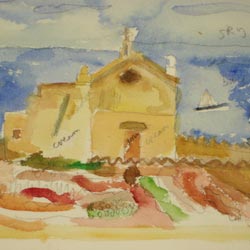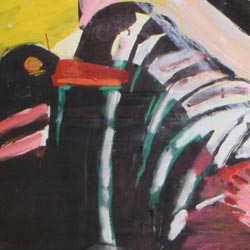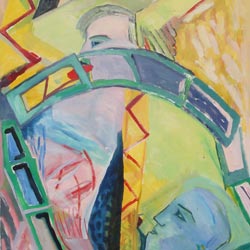Life

Artistic Inspiration
Anna's mother & father were both painters & designers. Her father Gerald Holtom, was the artist and designer who created the iconic 'Ban The Bomb', CND symbol in 1958, together with a myriad of bright and clever fabric patterns and designs, many of which are in the Victoria & Albert Museum. Her mother taught Anna the care and diligence necessary to construct drawings and watercolours, as well as wood and lino cutting and engraving. Both parents greatly influenced her first artistic endeavours. Later at the Royal Academy as a pupil of William Scott she was 'adopted' and 'schooled' in a variety of techniques.
The work of artists like Duncan Grant and Eric Ravilious, encountered through an aunt, who lived in Richmond, provided powerful inspiration too. She was however influenced by more than just painting; the varied artists of the Omega workshop, encountered in her parent's circle of friends and colleagues, exposed her to printmaking, decorative porcelain, fabrics and painted finishes. All this, together with screens and mirror surrounds created by Duncan Grant, also motivated her work.
The Early Years
Although in 1958 Anna was drawn into the maelstrom surrounding her father's creation of the CND-Ban The Bomb symbol and all that followed the first Aldermaston march, it was also business as usual at Putney High School where she won the mural prize. From then on she studied and painted everything around her. In Norfolk where she later lived with her mother, that meant nature in the form of field and woodland; the changing seasons, and even animal skeletons guided her hand.
At Norwich School of Art, she studied wood engraving and created a number of large collage murals.
Anna studied at Ravensbourne Art School and later at the Royal Academy, where she won the landscape Prize. It was here that her work caught the attention and admiration of her tutor William Scott. Beyond the Academy she was later to become his Daughter-in-Law. That meant working, watching and listening, alongside the great man.
She won the Prix de Rome Scholarship at the Royal Academy. This gave her a year in Rome, during which she presented her work in a mixed exhibition mounted by the British Council.
Her work was also exhibited at the Young Contemporaries Show, in London's Mall Galleries.
More Recently...
Anna taught at Hornsey College of Art and at Ravensbourne Art College. For a while she pursued her work at a Studio in Radnor Walk, Chelsea and later at a studio in Vauxhall. The latter, again under the tutelage of William Scott.
In recent years she has returned to studios in Vauxhall following a short period in Hove and Battersea.
Earlier periods of work, coinciding with bringing up a family, were notable for large figurative works, although recently Anna has focused on still life, landscape and latterly some animal paintings.
In 1985 she was invited to take part and exhibit her work in a cultural exchange to Warsaw, Poland.
A Life of Extremes
Since the 1980's Anna has painted in various parts of the Mediterranean, most recently in France and Italy.
Although Valentine motifs and still life dominated an earlier exhibition, her work has wandered in many directions depending on season and mood. She has a passion for woodcuts and wood engraving, but Anna has often found herself capturing, in oils, the sometimes violent tensions inherent in modern, domestic life. This is where Anna's winter 2012 exhibition, at the Menier Gallery, 'Going Missing at Midnight' found its influence.
In exploring the paintings at the Menier Gallery one should not forget that there is another aspect of her work which embraces the briefly vibrant majesty of flowers and vegetables; on occasions the passing glory of domestic architecture, together with the peace of the Sussex coast and the French countryside. Anna also has a particular fondness for escaping, with her watercolours, to capture the River Thames, or London's Parks and the dogs that play there.
Anna Scott has lived a life of extremes, in both her working, social and family life.
Being the daughter of a legendary, opinionated artist and designer, guided by a mother who brusquely radiated all the talents of pure art, and then being 'adopted' as a pupil by the iconic genius William Scott; it is hardly surprising that Anna Scott's work is as varied and challenging as any artist of her time...
Browse Anna's Work >Events...
Anna Scott and Robin Holtom – Hastings Art Forum June 2013
Posted 05/06/2013
Anna’s new exhibition is unleashed
Posted 12/04/2012
Going Missing at Midnight
Posted 09/01/2012


